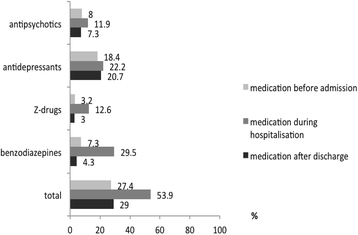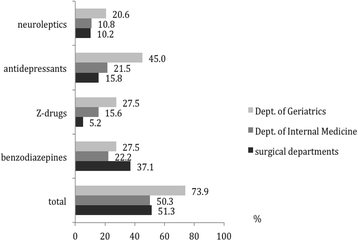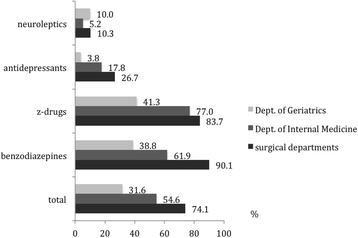High prevalence of prescription of psychotropic drugs for older patients in a general hospital
- PMID: 29202811
- PMCID: PMC5715648
- DOI: 10.1186/s40360-017-0183-0
High prevalence of prescription of psychotropic drugs for older patients in a general hospital
Abstract
Background: Many elderly patients receive psychotropic drugs. Treatment with psychotropic agents is associated with serious side effects including an increased risk of falls and fractures. Several psychotropic drugs are considered potentially inappropriate for treatment of the elderly.
Methods: A retrospective chart review was conducted covering all patients aged ≥ 65 years who were admitted to Evangelisches Krankenhaus Göttingen-Weende between 01/01/2013 and 03/31/2013. Psychotropic drugs reviewed for included benzodiazepines, Z-drugs, antidepressants and neuroleptics, but not drugs for sedation during artificial ventilation or pre-medication before surgery. Potentially inappropriate drugs were identified according to the PRISCUS list. To assess which factors were associated with the administration of psychotropic drugs, univariate and multivariable logistic regression analyses were performed.
Results: The charts of 2130 patients (1231 women) were analyzed. 53.9% of all patients received at least one psychotropic medication (29.5% benzodiazepines, 12.6% Z-drugs, 22.2% antidepressants, 11.9% neuroleptics). The mean number of psychotropic drugs prescribed per patient with at least one prescription was 1.6. Patients treated in the geriatric department most often received antidepressants (45.0%), neuroleptics (20.6%) and Z-drugs (27.5%). Benzodiazepines and Z-drugs were prescribed mostly as medication on demand (77.7% of benzodiazepines, 73.9% of Z-drugs). Surgical patients most frequently received benzodiazepines (37.1%). Nearly one-third of all patients ≥ 65 years was treated with at least one potentially inappropriate psychotropic medication. The mean number of potentially inappropriate psychotropic medications per patient with at least one psychotropic prescription was 0.69. The percentage of patients with potentially inappropriate psychotropic medication was highest in the surgical departments (74.1%). Female gender (adjusted OR 1.36; 95% CI 1.14 to 1.63), stay in the Department of Geriatrics (2.69; 2.01 to 3.60) or the interdisciplinary intensive care unit (1.87; 1.33 to 2.64) and age ≥ 85 years (1.33; 1.10 to 1.60) were associated with psychotropic drug treatment.
Conclusions: A high percentage of patients aged ≥ 65 years received psychotropic drugs. The chance that a potentially inappropriate psychotropic drug would be administered was highest in the surgical departments. Antidepressants, neuroleptics and Z-drugs were used surprisingly often in geriatric medicine. Educational strategies could reduce the use of psychotropic drugs and the prescription of potentially inappropriate medications.
Keywords: Drug use; Elderly; Hospital; Pharmacoepidemiology; Psychotropic drugs; Retrospective study.
Conflict of interest statement
Ethics approval and consent to participate
The study was approved by the Ethics Committee of the University Medical Center Göttingen (reference number: 25/2/14). Data were stored on a protected server of the University Medical Center Göttingen. The questionnaire was password-protected and taken offline after the completion of the data collection. Since the study was a retrospective chart review, did not comprise any interventions and data were processed anonymously, the Ethics Committee waived the need for consent of the patients to participate.
Consent for publication
Not applicable
Competing interests
The authors declare that they have no competing interests.
Publisher’s Note
Springer Nature remains neutral with regard to jurisdictional claims in published maps and institutional affiliations.
Figures



Similar articles
-
Potentially inappropriate medication in older psychiatric patients.Eur J Clin Pharmacol. 2021 Mar;77(3):331-339. doi: 10.1007/s00228-020-03012-w. Epub 2020 Oct 8. Eur J Clin Pharmacol. 2021. PMID: 33029652
-
Prescribing potentially inappropriate psychotropic medications to the ambulatory elderly.Arch Intern Med. 2000 Oct 9;160(18):2825-31. doi: 10.1001/archinte.160.18.2825. Arch Intern Med. 2000. PMID: 11025793
-
Prescription of potentially inappropriate medication in Korean older adults based on 2012 Beers Criteria: a cross-sectional population based study.BMC Geriatr. 2016 Jun 2;16:118. doi: 10.1186/s12877-016-0285-3. BMC Geriatr. 2016. PMID: 27255674 Free PMC article.
-
Psychotropic medications in older adults: a review.Psychiatr Danub. 2016 Mar;28(1):13-24. Psychiatr Danub. 2016. PMID: 26938816 Review.
-
Are potentially inappropriate and anticholinergic medications being prescribed for institutionalized elderly subjects?Fundam Clin Pharmacol. 2020 Dec;34(6):743-748. doi: 10.1111/fcp.12560. Epub 2020 May 17. Fundam Clin Pharmacol. 2020. PMID: 32289182 Review.
Cited by
-
Prevalence and risk factors of drug-related problems identified in pharmacy-based medication reviews.Int J Clin Pharm. 2020 Apr;42(2):588-597. doi: 10.1007/s11096-020-00976-8. Epub 2020 Feb 5. Int J Clin Pharm. 2020. PMID: 32026355 Free PMC article.
-
Trends in use of antipsychotics and psychoactive drugs in older patients after major surgery.J Am Geriatr Soc. 2023 Dec;71(12):3755-3767. doi: 10.1111/jgs.18580. Epub 2023 Sep 7. J Am Geriatr Soc. 2023. PMID: 37676699 Free PMC article.
-
Changes of consultation-liaison psychiatry practice in Italian general hospitals: A comparative 20-year multicenter study.Front Psychiatry. 2022 Oct 14;13:959399. doi: 10.3389/fpsyt.2022.959399. eCollection 2022. Front Psychiatry. 2022. PMID: 36311528 Free PMC article.
-
Comorbidity and Treatment in Older Psychiatric In-patients-A Retrospective Study in a Chinese Psychiatric Hospital.Front Psychiatry. 2021 Oct 26;12:722329. doi: 10.3389/fpsyt.2021.722329. eCollection 2021. Front Psychiatry. 2021. PMID: 34764894 Free PMC article.
-
Factors associated with psychotropic drugs use in older adults hospitalized in clinical and surgical wards of a university hospital.Dement Neuropsychol. 2025 Jul 11;19:e20240228. doi: 10.1590/1980-5764-DN-2024-0228. eCollection 2025. Dement Neuropsychol. 2025. PMID: 40671886 Free PMC article.
References
-
- Landi F, Onder G, Cesari M, Barillaro C, Russo A, Bernabei R, Silver Network Home Care Study Group Psychotropic medications and risk for falls among community-dwelling frail older people: an observational study. J Gerontol A Biol Sci Med Sci. 2005;60:622–626. doi: 10.1093/gerona/60.5.622. - DOI - PubMed
MeSH terms
Substances
Grants and funding
LinkOut - more resources
Full Text Sources
Other Literature Sources

